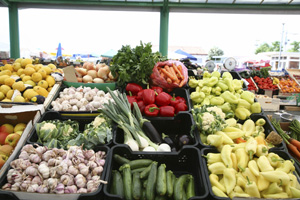
Farmers’ markets are also a great resource for organic foods. You will find the freshest, in-season, most reasonably priced, delicious produce at these open-air cornucopias.
by Lynn O’Neill —
If you value what organic food has to offer but never thought you could afford to make the switch, here are some tips for getting started. Eating healthily will require some planning, but you can start slowly and make it fun.
First, remember what your mother told you — never go to the grocery store hungry. If you do your shopping after a meal, you will be less likely to reach for the instant gratification of pre-packaged foods. If you must have that box of cane-juice-sweetened organic cookies, then go for it; but remember pre-made snacks may not be your ideal transition food from conventional to organic. Produce, meat, dairy and food for your children should be your first priority. You may have been raised on Twinkies and bologna sandwiches, but your kids sure don’t have to be. Teach them young.
Begin with a short list of the items you want to switch from conventional to organic. Certain fruits and vegetables are a good place to start because their pesticide loads are significant. Organic and local produce invariably tastes better, too. However, health concerns are not relegated to conventional produce alone. With regard to non-produce foods, many conventional meat and dairy items are derived from factory-farmed animals injected with growth hormones and antibiotics.
The fruits and vegetables with the highest pesticide load, starting with the most notorious, are peaches, followed by apples, sweet bell peppers, celery, nectarines, strawberries, cherries, lettuce, imported grapes, pears, spinach and potatoes. The five cleanest are onions, avocados, sweet corn (frozen), pineapples and mangoes.
Before you even leave the house, do a little online research. Three helpful Web sites are: www.cooperativegrocer.coop, www.foodnews.org and www.localharvest.org. They can point you in the direction of member-owned co-ops and natural grocery stores where you can save money — especially if you buy in bulk and according to what is on sale that week. Even Trader Joe’s and the warehouse stores are carrying more organics.
The benefits of joining a co-op, however, are that the staff will do the hard work for you; they will thoroughly read and research all micro-ingredients and organic certification requirements so that you do not have to. You will pay a yearly fee (sometimes as low as $15) to belong. A good co-op is often more community than mere store. They sponsor seminars and classes on all things healthy, or throw parties and picnics so you can sample recipes and learn first-hand about which foods are safe, delicious and affordable.
You also can clip printed coupons or participate in online coupon programs. Check your favorite vendors’ Web sites. Make sure to get your name on the mailing lists of your preferred stores to receive their weekly and monthly circulars — this also makes menu planning easier.
Remember to buy in bulk when you can — especially grains, beans, nuts and even dried soup mixes you can build upon. Buy the store brands, as well. These are generally co-packaged by the bigger companies, so you are getting the reputable ingredients without the high price.
Farmers’ markets are also a great resource for organic and non-GMO foods. You will find the freshest, in-season, most reasonably priced, delicious produce at these open-air cornucopias. However, if you do not see signs that say organic on your favorite foods, make sure to ask. Talk to the purveyors anyway, to begin establishing relationships — you might be able to get a reduced price for misshapen or slightly blemished fruits and veggies. Have fun with the experience.
Pretend you are Audrey Hepburn in the south of France for the day, haggling with the locals. You can even speak to your closest neighborhood store if you would like them to carry a favorite organic product. As a local consumer, you have the power.
Once you have experienced the freedom and freshness of the farmers’ market, you might want to take the next step toward a CSA (community-supported agricultural program) or buying club. With the CSA, you buy a share or a half-share in a local farm. Buying clubs are often made up of friends and neighbors who get together to purchase produce in bulk. This can save you money — sometimes up to 40 percent off the usual retail price. Check with your local co-op for details about clubs in your area.
Do not forget to “buy in season and do the freezin’.” Buying produce at the peak of its respective season and freezing it is a great money-saving tool. Also, consider having a small plot in your backyard. Tomatoes, carrots, radishes and beets are easy first crops.
Remember that food is communal. Tell your friends, family and coworkers of your intentions, and you will be surprised how many people come out of the woodwork to give you shopping tips, recipes and creative strategies for extending the budget.
Last, but not least, be flexible. If you want to support a healthy, organic, non-factory-farmed industry, certain items may cost more (but not always), so cut back in other discretionary areas, at least while you are starting out.
The closer you are to your food’s healthy, organic origin, the better the price and the tastier and fresher it will be. It is not rocket science — although homegrown rocket, a.k.a arugula, is scrumptious.
Lynn O’Neill is a native Arizonan living in California. She is a freelance fiction writer, editor, essayist and natural products broker. jasminatree@yahoo.com
Reprinted from AzNetNews, Volume 26, Number 4, August/September 2007.





September 16, 2012
Chemical and Toxic Exposure, Farmers' markets, Food, Nutrition and Diet, Fruits and Vegetables, Genetically modified, Organic